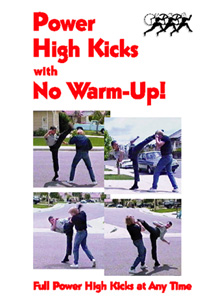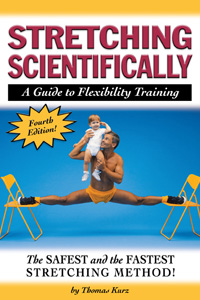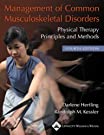by Thomas Kurz
Information on this Web page is for educational use only, and is not intended as medical advice.
Every attempt has been made for accuracy, but none is guaranteed. If you have any serious health concerns, you should always check with your health care practitioner before treating yourself or others.
Always consult a physician before beginning or changing any fitness program.
In this article I will answer typical questions on injuries, their causes and treatments.
Question: I started studying Taekwondo 7 months ago and I have advanced to green belt. This last month, I have noticed when I first get out of bed that the backs of my ankles are stiff and sore. By the time I make it to the bathroom, I am fine. I’m fine for the rest of the day. So it’s only after lying still for several hours that they get this way.
I can’t figure out what happened to make my ankles do this. I practice nightly on carpet, doing my spin kicks, pivots with the forms—can that be what’s causing this?
They are not sore to the touch and I do warm up before working out: light stretches or riding my bike.
I’m curious as to why [this soreness] would start now after 7 months of the same type training. I do remember working particularly hard one evening, and perhaps I hurt them, then didn’t give them the proper rest?
Answer: From the little information you provide (soreness in the back of the ankles that recedes after a few steps), I may guess that you have either inflamed Achilles tendons or arthritis. You need to see a sports medicine specialist or a doctor specializing in applied kinesiology to find out what injury you have and how to treat it before it gets much worse.
Your warm-up is bad—pedaling on a bike is not similar enough to Taekwondo activities. You do not specify what “light stretches” you do. If you do static stretches, then in the best case you waste time, and in the worst case you set yourself up for injury.
Also, your statement that you have done the same training for 7 months, right from the start of studying Taekwondo, tells me that you have not done sufficient (if any) conditioning and practicing of basics before attempting to do jumping and spinning kicks.
Plunging into intensive training or intensifying it suddenly, without a long period of slow adaptation to gradually increasing loads, predisposes an athlete to gradual-onset injuries.
There are two mechanisms for the origin of gradual-onset injuries. The first, obvious to most athletes, is when tissues stressed by exercises do not have enough time or nutrition to rebuild between workouts and so are gradually torn down to the point at which they come apart. The result—a muscle, a tendon, a ligament, or a joint cartilage is torn, or a bone is broken.
The second mechanism is less obvious because the stressed tissues are supplied well with nutrition and have enough rest time to rebuild themselves or even grow bigger but the loads are too great or occur too often for new tissues to mature. Maturation of tissues involves orientation of collagen fibers along the lines of mechanical stress and production of enough of a matrix (ground substance) to preserve the normal collagen-to-matrix ratio and to prevent excessive bonding of collagen fibers (Hertling and Kessler 1996).
Not allowing new tissues to mature makes them rigid, not extensible, so they do not damp the forces applied to them by extending and then returning to their original shape. They either break down or pass on these nonattenuated forces to other tissues. For example, increased stiffness of a tendon (fibrosis) increases the strain on its attachment to the bone, leading to inflammation and eventual separation from the bone. In the case of increased stiffness of bone (sclerosis) under joint cartilage, the cartilage is excessively stressed by loading because it lies between stiffer-than-normal bones—between a rock and a hard place. (Bone hypertrophies quicker than joint cartilage in response to loading because bone has a good blood supply and cartilage does not.)
Gradual-onset injury initially announces itself by intermittent dull pain not severe enough to stop the athlete from exercising. If the athlete ignores this light pain the injury is aggravated and the pain is felt during and continuously after the exercise. If further ignored the injury progresses to an acute injury that may require an operation and may end an athletic career.
I have two questions of my own:
1. What type of flooring is installed in your gym? A stiff floor wears down joints by making them absorb the whole force of every impact.
2. What do you mean by “7 months of the same type training”? The same exercises, in the same amounts, in the same form? If yes, then no wonder you get stiff and sore.
Question: Mr. Kurz, I discovered your book Stretching Scientifically in 1992 and it did wonders for me. Here is my problem. I used to compete seriously in Taekwondo up until 1994. I then quit to go to college. Now I am trying to get back into it. About a month ago I tore my right hamstring pretty high in the muscle. It was not a very serious tear and is healing nicely. Due to extensive use and abuse when I was younger, both my hamstrings and the adductors of both legs are susceptible to injury (especially at their origins close to the pelvis). My question:
In your book you mention that connective tissue must be strengthened if muscles are not ready for isometric stretching. This is done through high rep work (30–100 repetition per set). How often should I train my weak muscles in this way per week?
Answer: The rest between workouts should be such as to allow improvements in performance, i.e., do more repetitions of the exercise or the same number with greater resistance so long as there is no increase in discomfort.
To treat your current and past chronic injuries as well as to find out the source of your problem with s, see a physician specializing in Applied Kinesiology.
You can find an AK specialist near you at www.icakusa.com.
If you have a choice, go to those doctors who are Diplomates of the International College of Applied Kinesiology and have the initials DIBAK after their names.
Question: I bought your video Power High Kicks with No Warm-Up! about a year ago, and it has been a revelation to me. I have been involved in Kyokushin Karate since 1984, and I can see why many of my friends now have knee problems due to improper technique. I haven’t been training much in the dojo over the last year, but I have been going to the gym, and my flexibility is probably better than it was ten years ago when I went for my black belt!
My question concerns the weight training I am now doing. I had never done much in the way of weight training before, and late last year I suffered a shoulder injury. I was told that I was probably not stretching my shoulders properly before and after weight training (I was having most problems with the incline bench press).
Having studied your video tape on kicking, I am uncertain that the stretching methods I have been shown [in my gym] are the most effective. These are static stretches resisting against a wall. Your “law of specificity” makes me wonder if there is a better way. Can you enlighten me?
Answer: You say that you “had never done much in the way of weight training before.” Perhaps you progressed too fast and caused a gradual-onset injury by a mechanism described in my answer to the first question in this article.
I do not believe that not stretching your shoulders has contributed to your injury. I never do any form of static stretching prior to weight lifting or any resistance exercises. Static stretches temporarily weaken and predispose to injury the stretched muscles (more information on this is in my previous article, Stretching and Injuries). Static stretches are to be done after and not before resistance exercises, but I am not aware of any detrimental effect of not stretching the shoulders after the resistance exercises. After all, if the resistance is not excessive and exercises are done at the full range of motion, they will not reduce it.
Your problem may have less to do with stretching and more with doing too much too soon, an improper form of movements, or an improper balance of exercises.
Question: Your book [Stretching Scientifically] and video [Secrets of Stretching] have enabled me to attain a much higher performance level in my Taekwondo training.
I’m 49 years old and in good shape; stretching has always been easy for me, and I can throw high roundhouse kicks pretty easily and accurately (I am working on my Green Belt in TKD and am a relative novice to the sport). You say that muscle soreness after a workout is a sign of overworking the connective tissue in the muscles and is a bad sign. But I have sore muscles a lot after workouts. Nothing debilitating—I even seem to be making progress. But recently, I’ve had problems with my hip flexors and have a pain in the muscle belly that won’t go away. I think this may be from doing the exercises you recommend in your book and tape. It may be that my body is just giving me less as I age. But I would like to eliminate the possibility that I’ve misunderstood your method and am doing something wrong. I do your dynamic stretch exercises before workouts, and feel great kicking. The next day I have a stiffness or a burn. I have backed off on all my workouts since the hip flexor (in my left leg) has begun pulling at me, and feel that rest is a good idea for it. But do you think it is all right for me to continue with the workouts you describe in your book and tape?
Answer: Soreness once in a great while is normal (after introducing new resistance exercises not gradually enough), but being sore after consecutive workouts is not. Apparently you are not ready for these exercises or not ready to do as much of them as you do.
Do not continue workouts you are not ready for. If you do you can tear your hip flexors. So far you are getting all the warning signs—soreness, burning, stiffness, pulling or shortening (perhaps because of the hip flexor spasm).
Additional comment:
Here is what this martial artist wrote after receiving the above answer: Many thanks for your generous reply to my query regarding hip flexor muscle soreness. I have slowed in my workouts and the situation is improving.
Question: I’m 29 years old and I twisted my knee while playing basketball. I had a couple of weeks of swelling and soreness. After RICE [Rest, Ice, Compression, Elevation] and crutches my knee is much better, but it still can get a “tight” feeling in it, especially in the morning. I read some articles that seem to point to a meniscus cartilage tear. I also visited a doctor 2 weeks after the accident and because of no pain or irregular movement of the knee he recommended physical therapy for 2–3 weeks. My question is that if it’s a tear, genetics aside, how much can cartilage repair itself? Do weight lifting, leg press, and squats help increase toughness of cartilage and are there any supplements to aid in the rebuilding process of the joint?
Answer: Joint cartilage does not have blood vessels and its superficial portions—articular surfaces that contact each other as the joint moves—receive nutrition by absorbing synovial fluid. Synovial fluid has to be pumped in and out of the cartilage by intermittent pressure on the joint caused by weightbearing or contracting the muscles crossing the joint in the course of everyday activities and exercises. Both immobilization of the joint and prolonged pressure interfere with the adequate exchange of nutrients and waste products in its cartilage.
Whether injured cartilage is toughened by exercises or torn down depends on the extent of the damage, whether the cartilage has healed sufficiently before beginning the exercise program, and on the progression of the loads and adequate rest. My own knee menisci were severely damaged while skiing in my youth and up to now tests of meniscus injury indicate that they are still damaged. Despite this my knees work perfectly well both while kicking and while wrestling. I use deadlifts and squats to stabilize my knees and I have progressed from very light weights to weights in excess of 200% of my body weight.
Regarding supplements I suggest you see a physician specializing in Applied Kinesiology. These physicians know tests for discovering which supplement matches best the needs of your body. A directory of Applied Kinesiology specialists is at www.icakusa.com.
In the next article I will continue to answer questions on sports injuries.
This article is based on the books Stretching Scientifically and Management of Common Musculoskeletal Disorders and DVDs Power High Kicks With No Warm-Up! and Secrets of Stretching. Get them now and have all of the info—not just the crumbs!
References
Hertling, D. and R. M. Kessler. 2005. Management of Common Musculoskeletal DisordersManagement of Common Musculoskeletal Disorders: Physical Therapy Principles and Methods. Philadelphia: Lippincott Williams & Wilkins.
Kurz, T. 2004. Secrets of Stretching: Exercises for the Lower Body. Island Pond, VT: Stadion Publishing Co., Inc.
Kurz, T. 2003. Stretching Scientifically. Island Pond, VT: Stadion Publishing Co., Inc.
Mierzejewski, M. 2005. Power High Kicks With No Warm-Up! Island Pond, VT: Stadion Publishing Co., Inc.





Dear Thomas
I am 44 male. Until a few years ago I was able to bend forward and touch my toes with my palms easily. However, since last 5 years I have seen an increase in my weight from 70 to 75kgs. And my tummy hanging below my belly button. I tried going to the gym in 2009-2010 and managed to cut back to 72kgs. But now I am again 76kgs.
Problem happened recently when I started doing my taekwondo warm-up rouutines again. I could feel some lower back spine pain when I started but the pain became less and less everyday. However, two weeks ago while sitting down and bending forward I suddenly felt a pull on my left side illiosacral joint just below the hip bone. For a few days every movement caused pain and Ihad to take complete rest.
Two days ago I was again trying to touch my feet with my palms whilestanding and I could touch my feet.
To add to this I had cooked chicken in some chinese Kung po style marinating in egg-white and then velveting for a minuite and then saute in oil. But this left the chicken half-cooked and caused vomitting and black watery stools. It could also be because I ate some dark chocolate biscuits.
now I have pain on the left side above my hip bone raidating upto the middle back.
What can I do to prevent my back muscle injuries? I feel my tummy fat could be the opposing muscle group adding unwanted strain to the back muscles. And it could be some kind of nutritional deficiency or disease of the intestines.
Thank you
Romi
I had no idea injuries were so common in sports, as i never had the issue, but I believe warm-up is the best way to reduce injury chances.
By the way, great post, very informative.